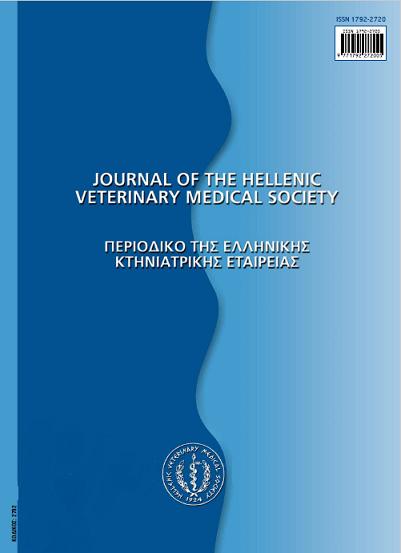Distal limb perfusion with amikacin in two horses
Abstract
Distal Limb Perfusion (DLP) involves the administration of a drug into the vasculature of a selected portion of thelimb that has been isolated from the systemic circulation by the application of a tourniquet (Rubio-Martinez and Cruz 2006). It is used to achieve high tissue concentrations of an antimicrobial in septic sites, while reducing undesirable systemic effects (Errico et al. 2008). DLP has been used as an adjunctive therapy in the treatment of sepsis improving greatly the outcome (Kramer 2006). In the present study, two cases of elimination of musculoskeletal sepsis are being presented. The first case is about a horse with chronic, partial hoof avulsion injury and infection of soft tissues. The second case is about a foal that presented with osteomyelitis of the third metatarsus bone. Both cases where treated with surgical debridment of the affected areas in conjuction with DLP and systemic therapy. For the first case, DLP targeted the hoof and it was performed through the lateral palmar digital vein with a solution of 125 mg of amikacin (Briklin®, Bristol-Myers Squibb) in 30 mL of 0,9% NaCl solution. For the second case, DLP targeted the metatarsus and it was performed through the medial saphenous vein with a solution of 250 mg of amikacin (Briklin®, Bristol-Myers Squibb) in 60 mL of 0,9% NaCl solution. The outcome of both patients was good despite their bad prognosis. DLP is a simple and effective method for treatment of septic conditions of the horse's distal limb, which is nowadays growing in popularity with promising results.
Article Details
- Come citare
-
ZAMBOULIS (Δ.Α. ΖΑΜΠΟΥΛΗ) D. A., & DIAKAKIS (Ν. ΔΙΑΚΑΚΗΣ) N. (2018). Distal limb perfusion with amikacin in two horses. Journal of the Hellenic Veterinary Medical Society, 61(2), 167–178. https://doi.org/10.12681/jhvms.14885
- Fascicolo
- V. 61 N. 2 (2010)
- Sezione
- Case Report

Questo lavoro è fornito con la licenza Creative Commons Attribuzione - Non commerciale 4.0 Internazionale.
Authors who publish with this journal agree to the following terms:
· Authors retain copyright and grant the journal right of first publication with the work simultaneously licensed under a Creative Commons Attribution Non-Commercial License that allows others to share the work with an acknowledgement of the work's authorship and initial publication in this journal.
· Authors are able to enter into separate, additional contractual arrangements for the non-exclusive distribution of the journal's published version of the work (e.g. post it to an institutional repository or publish it in a book), with an acknowledgement of its initial publication in this journal.
· Authors are permitted and encouraged to post their work online (preferably in institutional repositories or on their website) prior to and during the submission process, as it can lead to productive exchanges, as well as earlier and greater citation of published work.












